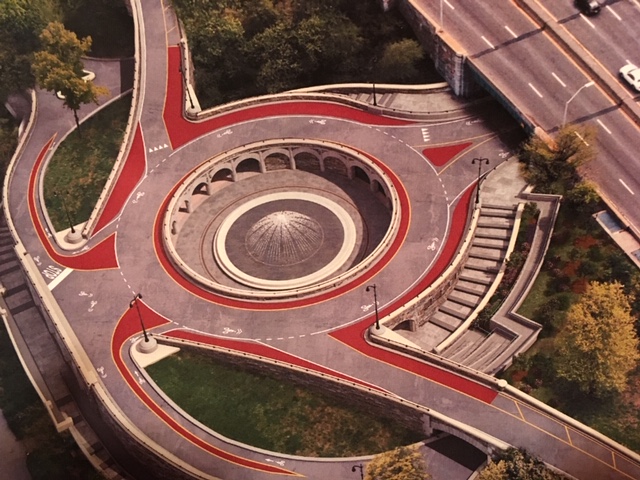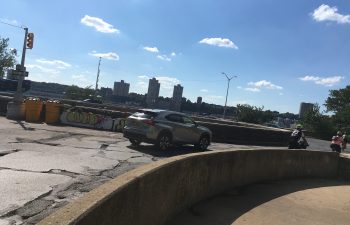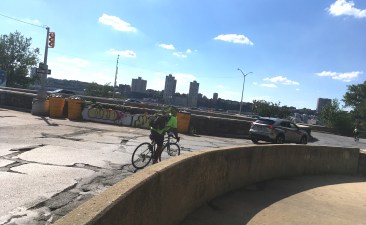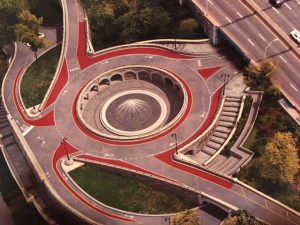Op-ed: DOT Rebuffs Community on Riverside Park Rotunda Traffic Safety

Last October, the Department of Transportation presented to Community Board 7 a $150- to 200-million plan to renovate the Rotunda at West 79th Street in Riverside Park. The Rotunda is topped by a traffic circle that cyclists use to get to the Hudson River Greenway, the busiest bike route in the country.
For years, cyclists seeking access to the Greenway there have mixed uneasily with the hundreds of cars that come whizzing off the Henry Hudson Parkway. Last October, DOT presented a plan to CB7 which CB7 found unsafe for cyclists and asked DOT to come back with a plan which was much safer for cyclists.
In December, DOT returned and presented another plan that still mixed cyclists with the traffic getting on and off the highway. The board and community condemned DOT for its failure to address the unsafe cycling conditions and again told DOT to find a safe way for cyclists to get from Riverside Drive to the Greenway.
After the December DOT meeting, I proposed a much safer solution which included a grade-separated bike path that removed the bike traffic from the traffic circle and routed it around the main rotunda structure.
My article generated interest from community members, and a group of us met, visited the site, discussed the various pros and cons of different proposals and, with the help of Reed Rubey and his fine architectural and drafting skills, presented solutions to DOT for their consideration.
The primary solution (see Option A, below) we proposed involved routing a grade-separated path around the Rotunda by passing it through the Rotunda’s underground parking garage.

If Option A proved unworkable, we presented an alternative (see Option B, below) that took the bike path off the traffic circle and routed it where it had a simpler interaction with traffic at the on-ramp to the southbound West Side Highway.

After sending our plans to DOT, we were heartened when we heard that DOT was taking a hard look at them. On May 9, DOT came back to CB7 and again presented a plan that left cyclists caught in a dangerous mix of highway and bus traffic. CB members and Upper West Side residents who attended the meeting uniformly condemned DOT’s failure to create safe-cycling infrastructure. After the meeting, Lisa Orman gathered comments from board and community members who attended. Here is a sampling of those comments:
Howard Yaruss wrote: “I am so troubled by the DOT’s continued indifference to safety, the concerns of the community, the Community Board, the goals of Vision Zero and the lives of the very people who pay their salaries. We clearly need to get our elected officials to start putting pressure on them to do their jobs properly.”
Ken Coughlin wrote: “The DOT Bridges division’s response to hazardous cycling conditions on the traffic circle is disappointingly unimaginative. In their restoration of a Robert Moses structure they seem mired in the Moses era. Maybe the first thing they need to do is build a bridge to the 21st century.”
Peter Frishauf wrote: “The dated, dangerous Rotunda design DOT wishes to impose on the Upper West Side is worse than doing nothing. DOT plans to direct bicyclists traveling to and from the nation’s most heavily used bike route — the Hudson River Greenway — through a dangerous Rotunda design. Injury and death — all preventable — will result. How does this square with Vision Zero? “
Engineering and bureaucratic indifference to safe cycling by the bridge’s division of DOT was on display at CB7. Not on display were a commitment to safety or creative engineering problem-solving.
DOT did show creativity in coming up with hollow excuses to dismiss the community’s valid suggestions. DOT insisted that a standard of 14 feet for the minimum width of the bike path prevented it from putting a grade-separated bike path through the 18-foot-wide garage entrance. The National Association of City Transportation Officials guideline for the minimum width of a bike lane is 3 feet. The rule that DOT cited may be a guideline, but DOT had no problem ignoring other applicable standards, such as the Manual on Uniform Traffic Control Devices rule stating that bikes should not mix with car traffic in a roundabout.
The DOT bridges division has installed a number of narrow bike and mixed-use paths on its bridges. Until recently, the Pulaski bridge had a 8.5-foot, mixed-use path that narrowed to 5 feet in some places. The Pulaski bridge path had a fair amount of foot and bike traffic, yet DOT saw it as a perfectly acceptable facility for decades. The Brooklyn Bridge pedestrian/bike path, which sees a torrent of walkers and bikers, narrows to as few as 10 feet in places and even fewer when the police vehicles parked on the bridge are taken into account.
The ramp down into the parking garage (see below) has a tight turn and low ceilings, so medium to large trucks can’t fit into the parking garage. Standard pickup trucks and large SUVs are all narrower than 7 feet, so there is an extra 11 feet for buffer space and a bike path.

The 18-foot-wide entrance to the parking garage could be split, with 10 feet for cars and trucks and 8 feet for bikes, so all users would have plenty of space. The garage entrance also is rarely used, minimizing possible conflicts, and the sharp curves at the garage entrance force motorized traffic to move slowly.
Similarly, DOT’s contention that the bike path is a mixed-use path does not stand scrutiny. In addition to the bike path, DOT’s plans for pedestrian access to the Rotunda has two sets of stairs and a handicap-accessible ramp. If, for some reason, a wheelchair chose to use the bike path, a biker could just slow down or go around them. Riding on a narrow path is far superior to facing a stream of traffic coming off of a highway. Their inability to take such factors into account shows that the DOT engineers working on this project lack valid mental models of how bikes and pedestrians operate in the real world.
When questioned, DOT acknowledged that a grade separated path is structurally feasible. So, from a construction perspective, the grade-separated path is a viable option.
With DOT’s acknowledgement that our first proposal is structurally feasible, our second proposal needs less consideration. Yet DOT’s dismissive reception of our second effort stands as another example of how DOT engineers play games and arbitrarily apply engineering standards to make bike safety seem impossible rather than putting their energy toward problem-solving.
DOT used a different, arbitrary and inappropriate engineering standard to dismiss our second option, the at-grade crossing of the bike path along the entrance ramp to the West Side Highway (Option B). This option is clearly inferior to a fully grade separated path, but we chose to present it in case structural reasons prevented the implementation of our first proposal.
DOT said that Option B would necessitate a traffic light at the point where the bike lane would cross the parkway entrance ramp, but traffic lights are not necessary to insure the safety of road crossings. By narrowing the entrance ramp at the bike-path crossing, DOT could engineer conditions that would cause drivers to slow.
Dutch engineers have learned that it is better to have cyclists be responsible for their own safety rather than to rely on drivers to yield to cyclists. At the point where the cycle path crosses the onramp, the cyclists would have a good line of sight and a simple traffic configuration (one-way traffic, no possible turns). In order to cross safely, cyclists only would need to wait for one of the frequent breaks in the traffic.
The DOT engineers disconnect from the real-world safety concerns of Upper West Side residents is disconcerting. DOT seems fine with having unsafe conditions in the Rotunda traffic circle. The department pretends that adding a few traffic signs will create safer conditions, even as it fails to address real problems.
Yet Upper West Siders have to live with the unsafe conditions forced upon them by DOT. They don’t have the luxury of considering a certain number of killed and injured neighbors and family members to be acceptable damage.
When it comes to catering to private motorists, DOT demonstrated determination and creativity when solving the challenging problem of allowing motorist nearly uninterrupted access to the highway during the four-year complete rebuild of the Rotunda. The Rotunda gets rebuilt once every 50 years. If DOT fails to provide safe cycling infrastructure, Upper West Side residents will be needlessly endangered for decades. We need DOT to to step up, engage with the community, and make a real effort to improve the cycling conditions on the Upper West Side. The era of bureaucratic indifference to safety needs to end.
Mark Gorton is publisher of Streetsblog.


